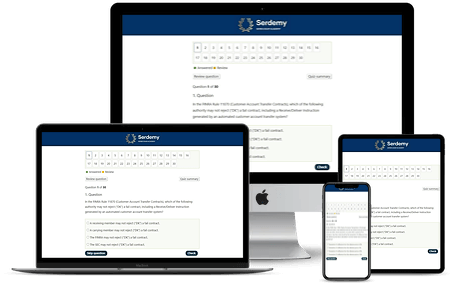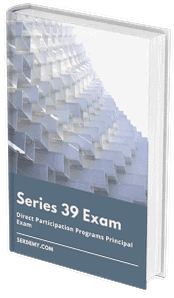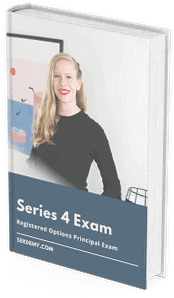Quiz-summary
0 of 30 questions completed
Questions:
- 1
- 2
- 3
- 4
- 5
- 6
- 7
- 8
- 9
- 10
- 11
- 12
- 13
- 14
- 15
- 16
- 17
- 18
- 19
- 20
- 21
- 22
- 23
- 24
- 25
- 26
- 27
- 28
- 29
- 30
Information
Premium Practice Questions
You have already completed the quiz before. Hence you can not start it again.
Quiz is loading...
You must sign in or sign up to start the quiz.
You have to finish following quiz, to start this quiz:
Results
0 of 30 questions answered correctly
Your time:
Time has elapsed
Categories
- Not categorized 0%
- 1
- 2
- 3
- 4
- 5
- 6
- 7
- 8
- 9
- 10
- 11
- 12
- 13
- 14
- 15
- 16
- 17
- 18
- 19
- 20
- 21
- 22
- 23
- 24
- 25
- 26
- 27
- 28
- 29
- 30
- Answered
- Review
-
Question 1 of 30
1. Question
Leon, a Series 26 principal at a broker-dealer specializing in mutual funds and variable products, is reviewing a written notice from Kalinda, a registered representative. Kalinda has disclosed her intent to assist a non-public software startup, founded by a close friend, in raising capital. Her role would be to introduce the startup to three accredited investors and she would receive a small percentage of any capital they invest. Assuming Leon determines the activity does not present any unmanageable conflicts of interest, what is his primary supervisory obligation under FINRA rules if the firm approves Kalinda’s participation?
Correct
The determination of the principal’s supervisory duty is derived from applying FINRA Rule 3280, Private Securities Transactions of an Associated Person. 1. Identify the nature of the activity: The representative, Kalinda, is assisting a startup in raising capital by introducing it to potential investors. This involves the sale of securities. 2. Classify the activity under FINRA Rules: Because the activity involves the sale of securities not sponsored by the member firm, it falls under FINRA Rule 3280 as a Private Securities Transaction (PST), not merely an Outside Business Activity (OBA) under Rule 3270. 3. Determine if compensation is involved: Kalinda will receive a percentage of the capital raised. This is direct financial compensation. 4. Apply the specific provision of Rule 3280 for compensated PSTs: When an associated person is to receive compensation for a PST, the member firm must, if it chooses to approve the person’s participation, record the transaction on its own books and records. Furthermore, the firm must supervise the person’s participation as if the transaction were executed on behalf of the member itself. 5. Conclusion: The principal’s primary obligation, upon approval, is to integrate the transaction into the firm’s supervisory and record-keeping systems. This situation requires a careful application of FINRA rules governing the conduct of associated persons outside of their normal duties for the member firm. Specifically, it highlights the critical distinction between an outside business activity and a private securities transaction. An outside business activity is generally any business conducted by a registered person outside the scope of their relationship with the member firm. However, when that activity involves the sale or distribution of securities, it is defined as a private securities transaction, often called “selling away,” and is governed by the more stringent requirements of FINRA Rule 3280. The rule further distinguishes between transactions for which the representative will receive compensation and those for which they will not. If no compensation is involved, the firm’s duty is to provide written acknowledgement and may require adherence to specific conditions. However, if any compensation is received, including commissions, fees, or any economic benefit, the firm’s obligations escalate significantly. Should the firm grant written approval for the compensated transaction, it is required to record the transaction on its books and records and supervise the activity with the same diligence as if it were one of the firm’s own offerings. This ensures the transaction is subject to the full scope of the firm’s supervisory system and compliance procedures.
Incorrect
The determination of the principal’s supervisory duty is derived from applying FINRA Rule 3280, Private Securities Transactions of an Associated Person. 1. Identify the nature of the activity: The representative, Kalinda, is assisting a startup in raising capital by introducing it to potential investors. This involves the sale of securities. 2. Classify the activity under FINRA Rules: Because the activity involves the sale of securities not sponsored by the member firm, it falls under FINRA Rule 3280 as a Private Securities Transaction (PST), not merely an Outside Business Activity (OBA) under Rule 3270. 3. Determine if compensation is involved: Kalinda will receive a percentage of the capital raised. This is direct financial compensation. 4. Apply the specific provision of Rule 3280 for compensated PSTs: When an associated person is to receive compensation for a PST, the member firm must, if it chooses to approve the person’s participation, record the transaction on its own books and records. Furthermore, the firm must supervise the person’s participation as if the transaction were executed on behalf of the member itself. 5. Conclusion: The principal’s primary obligation, upon approval, is to integrate the transaction into the firm’s supervisory and record-keeping systems. This situation requires a careful application of FINRA rules governing the conduct of associated persons outside of their normal duties for the member firm. Specifically, it highlights the critical distinction between an outside business activity and a private securities transaction. An outside business activity is generally any business conducted by a registered person outside the scope of their relationship with the member firm. However, when that activity involves the sale or distribution of securities, it is defined as a private securities transaction, often called “selling away,” and is governed by the more stringent requirements of FINRA Rule 3280. The rule further distinguishes between transactions for which the representative will receive compensation and those for which they will not. If no compensation is involved, the firm’s duty is to provide written acknowledgement and may require adherence to specific conditions. However, if any compensation is received, including commissions, fees, or any economic benefit, the firm’s obligations escalate significantly. Should the firm grant written approval for the compensated transaction, it is required to record the transaction on its books and records and supervise the activity with the same diligence as if it were one of the firm’s own offerings. This ensures the transaction is subject to the full scope of the firm’s supervisory system and compliance procedures.
-
Question 2 of 30
2. Question
Ananya, a Series 26 principal at a limited broker-dealer, is reviewing a proposed seminar presentation submitted by Leo, a registered representative. The presentation, aimed at pre-retirees, focuses on a specific variable annuity product. Ananya notes the following issues: the presentation contains hypothetical illustrations that project high rates of return without disclosing that they are hypothetical or accounting for fees; it includes a slide promoting a “proprietary retirement planning software” that Leo sells independently and has not disclosed to the firm; and the presentation’s narrative strongly suggests the variable annuity is an ideal solution for every attendee. If Ananya were to approve these materials for public use, what would constitute her most significant supervisory failure under FINRA rules?
Correct
The core responsibility of a Series 26 principal under FINRA Rule 3110 is to establish, maintain, and enforce a system to supervise the activities of each registered person that is reasonably designed to achieve compliance with applicable securities laws and regulations, and with applicable FINRA rules. In the described scenario, the seminar materials presented by the registered representative, Leo, contain multiple, distinct, and serious violations. First, the materials violate FINRA Rule 2210 (Communications with the Public) and Rule 2211 (Communications with the Public About Variable Life Insurance and Variable Annuities). The use of promissory language like “guaranteed high returns” is explicitly prohibited, and the hypothetical performance illustrations lack the required disclosures about their nature, the impact of fees, and the fact they do not represent actual investment performance. This constitutes misleading communication. Second, the promotion of a proprietary software constitutes an outside business activity (OBA) under FINRA Rule 3270. Leo has not provided prior written notice to the firm, and the firm has not approved this activity. The principal’s review should have identified this undisclosed OBA. Third, the blanket recommendation of a single, complex variable annuity for all seminar attendees, without any consideration of individual circumstances, is a flagrant violation of the suitability obligations under FINRA Rule 2111, which requires reasonable-basis, customer-specific, and quantitative suitability determinations. A principal’s approval of these materials would not be a single, isolated error. It would represent a fundamental failure of the entire supervisory system required by Rule 3110. By approving the materials, the principal would be failing to enforce the firm’s written supervisory procedures concerning communications, outside business activities, and suitability simultaneously. Therefore, the most significant failure is the overarching breakdown in the supervisory process, as it permits multiple, compounded violations to occur.
Incorrect
The core responsibility of a Series 26 principal under FINRA Rule 3110 is to establish, maintain, and enforce a system to supervise the activities of each registered person that is reasonably designed to achieve compliance with applicable securities laws and regulations, and with applicable FINRA rules. In the described scenario, the seminar materials presented by the registered representative, Leo, contain multiple, distinct, and serious violations. First, the materials violate FINRA Rule 2210 (Communications with the Public) and Rule 2211 (Communications with the Public About Variable Life Insurance and Variable Annuities). The use of promissory language like “guaranteed high returns” is explicitly prohibited, and the hypothetical performance illustrations lack the required disclosures about their nature, the impact of fees, and the fact they do not represent actual investment performance. This constitutes misleading communication. Second, the promotion of a proprietary software constitutes an outside business activity (OBA) under FINRA Rule 3270. Leo has not provided prior written notice to the firm, and the firm has not approved this activity. The principal’s review should have identified this undisclosed OBA. Third, the blanket recommendation of a single, complex variable annuity for all seminar attendees, without any consideration of individual circumstances, is a flagrant violation of the suitability obligations under FINRA Rule 2111, which requires reasonable-basis, customer-specific, and quantitative suitability determinations. A principal’s approval of these materials would not be a single, isolated error. It would represent a fundamental failure of the entire supervisory system required by Rule 3110. By approving the materials, the principal would be failing to enforce the firm’s written supervisory procedures concerning communications, outside business activities, and suitability simultaneously. Therefore, the most significant failure is the overarching breakdown in the supervisory process, as it permits multiple, compounded violations to occur.
-
Question 3 of 30
3. Question
Pioneer Funds Distributors, a FINRA member firm specializing in mutual funds and variable products, had 15 registered representatives. The firm then hired a group of five registered representatives, all of whom were previously employed by “Momentum Investments,” a firm that was expelled from FINRA six months ago for systemic sales practice violations. Shortly after, Anjali, Pioneer’s Series 26 principal, is notified of a written customer complaint against one of the new hires, Marco, alleging aggressive sales tactics and misrepresentation of a deferred variable annuity’s mortality and expense risk charges. Given these circumstances, which of the following actions represents the most comprehensive and compliant supervisory response Anjali must orchestrate?
Correct
First, determine if FINRA Rule 3170 (Taping Rule) is triggered. The rule applies to firms of a certain size that hire a specified percentage of registered persons from disciplined firms. For a member firm with 20 or more registered persons, the rule is triggered if 20% or more of its registered persons have been associated with one or more disciplined firms within the last three years. A firm expelled by FINRA is considered a disciplined firm. Calculation of the percentage: Total registered persons = 15 existing + 5 new hires = 20 persons. Number of persons from disciplined firm = 5. Percentage from disciplined firm = (5 / 20) * 100 = 25%. Since 25% is greater than the 20% threshold for a firm of this size, the Taping Rule is triggered. The firm must implement tape-recording procedures within 60 days of the rule being triggered. Next, address the customer complaint. Under FINRA Rule 4513, the firm must maintain a file of all written customer complaints and any action taken by the member. Under FINRA Rule 3110, the principal has a duty to supervise and investigate the complaint promptly. The investigation must determine the merits of the allegation regarding misrepresentation of the variable annuity’s features. Finally, consider the reporting obligations. The principal must evaluate if the complaint’s allegations require an amendment to the representative’s Form U4. Specifically, Question 14I(3) asks about written customer complaints alleging sales practice violations. An affirmative answer may be required. The complaint must also be included in the firm’s quarterly statistical and summary information report to FINRA under Rule 4530. A comprehensive response integrates all these distinct but related regulatory obligations. FINRA Rule 3170, the Taping Rule, is designed to provide heightened supervision over firms that hire a significant number of individuals from firms with a history of misconduct. When a firm crosses the specified percentage thresholds, it is required to establish, maintain, and enforce special written procedures for supervising the telemarketing activities of all its registered persons. This includes the tape recording of all telephone conversations between its registered persons and both existing and potential customers. The firm has 60 days to implement these procedures after being notified by FINRA or otherwise learning that it is subject to the rule. Separately, the handling of a written customer complaint is a critical supervisory function. FINRA Rule 3110 requires a firm to have a supervisory system in place to review and investigate such complaints. The complaint must be documented and maintained in a central file as required by Rule 4513. The principal must also assess whether the nature of the complaint triggers a disclosure event on the representative’s Form U4, which requires prompt amendment. This holistic approach ensures compliance with rules governing both firm-level supervisory systems and individual representative conduct.
Incorrect
First, determine if FINRA Rule 3170 (Taping Rule) is triggered. The rule applies to firms of a certain size that hire a specified percentage of registered persons from disciplined firms. For a member firm with 20 or more registered persons, the rule is triggered if 20% or more of its registered persons have been associated with one or more disciplined firms within the last three years. A firm expelled by FINRA is considered a disciplined firm. Calculation of the percentage: Total registered persons = 15 existing + 5 new hires = 20 persons. Number of persons from disciplined firm = 5. Percentage from disciplined firm = (5 / 20) * 100 = 25%. Since 25% is greater than the 20% threshold for a firm of this size, the Taping Rule is triggered. The firm must implement tape-recording procedures within 60 days of the rule being triggered. Next, address the customer complaint. Under FINRA Rule 4513, the firm must maintain a file of all written customer complaints and any action taken by the member. Under FINRA Rule 3110, the principal has a duty to supervise and investigate the complaint promptly. The investigation must determine the merits of the allegation regarding misrepresentation of the variable annuity’s features. Finally, consider the reporting obligations. The principal must evaluate if the complaint’s allegations require an amendment to the representative’s Form U4. Specifically, Question 14I(3) asks about written customer complaints alleging sales practice violations. An affirmative answer may be required. The complaint must also be included in the firm’s quarterly statistical and summary information report to FINRA under Rule 4530. A comprehensive response integrates all these distinct but related regulatory obligations. FINRA Rule 3170, the Taping Rule, is designed to provide heightened supervision over firms that hire a significant number of individuals from firms with a history of misconduct. When a firm crosses the specified percentage thresholds, it is required to establish, maintain, and enforce special written procedures for supervising the telemarketing activities of all its registered persons. This includes the tape recording of all telephone conversations between its registered persons and both existing and potential customers. The firm has 60 days to implement these procedures after being notified by FINRA or otherwise learning that it is subject to the rule. Separately, the handling of a written customer complaint is a critical supervisory function. FINRA Rule 3110 requires a firm to have a supervisory system in place to review and investigate such complaints. The complaint must be documented and maintained in a central file as required by Rule 4513. The principal must also assess whether the nature of the complaint triggers a disclosure event on the representative’s Form U4, which requires prompt amendment. This holistic approach ensures compliance with rules governing both firm-level supervisory systems and individual representative conduct.
-
Question 4 of 30
4. Question
Anika, a Series 26 principal at a limited broker-dealer, is reviewing the activities of Leo, a registered representative. Leo recently conducted a seminar for 35 prospective clients using a firm-approved slide deck and script. During the question-and-answer portion, in an attempt to be helpful, Leo used a publicly available, third-party retirement calculator website to project potential investment outcomes for an attendee based on their inputs. This website and its underlying methodology had not been reviewed or approved by the firm. Following the event, Leo sent personalized follow-up emails to 20 of the attendees. An assessment of this situation by Anika should identify which of the following as the most significant supervisory failure?
Correct
The core issue is the registered representative’s use of an unapproved, interactive, third-party website during a seminar. Under FINRA Rule 2210, communications with the public are categorized as correspondence, retail communication, or institutional communication. A seminar for prospective clients is considered retail communication. While the main presentation was scripted and pre-approved by a principal as required, the spontaneous use of an external, interactive tool also constitutes retail communication. This is because it provides projections and analysis to a retail audience. Specifically, FINRA Rule 2214 governs the use of investment analysis tools. This rule requires that the member firm provide a basis for the tool’s evaluation, explain its methodology, and make it available to customers. By using an unvetted, third-party tool, the representative bypassed the firm’s essential supervisory duty to vet the tool’s assumptions, methodology, and disclosures for fairness and accuracy. This action exposes the firm and clients to significant risk from potentially misleading or flawed projections. The follow-up emails, sent to 20 attendees, fall under the definition of correspondence (25 or fewer retail investors within 30 days) and are subject to post-use review and supervision, not pre-approval, making their dispatch less of an immediate supervisory failure than the use of the unapproved tool. The primary violation is the introduction of unapproved retail communication into a public forum.
Incorrect
The core issue is the registered representative’s use of an unapproved, interactive, third-party website during a seminar. Under FINRA Rule 2210, communications with the public are categorized as correspondence, retail communication, or institutional communication. A seminar for prospective clients is considered retail communication. While the main presentation was scripted and pre-approved by a principal as required, the spontaneous use of an external, interactive tool also constitutes retail communication. This is because it provides projections and analysis to a retail audience. Specifically, FINRA Rule 2214 governs the use of investment analysis tools. This rule requires that the member firm provide a basis for the tool’s evaluation, explain its methodology, and make it available to customers. By using an unvetted, third-party tool, the representative bypassed the firm’s essential supervisory duty to vet the tool’s assumptions, methodology, and disclosures for fairness and accuracy. This action exposes the firm and clients to significant risk from potentially misleading or flawed projections. The follow-up emails, sent to 20 attendees, fall under the definition of correspondence (25 or fewer retail investors within 30 days) and are subject to post-use review and supervision, not pre-approval, making their dispatch less of an immediate supervisory failure than the use of the unapproved tool. The primary violation is the introduction of unapproved retail communication into a public forum.
-
Question 5 of 30
5. Question
Assessment of a new marketing initiative at a limited broker-dealer reveals that a registered representative, Mateo, wants to use a third-party software program that qualifies as an “investment analysis tool” under FINRA rules. The tool generates customized hypothetical illustrations of potential future values for a complex variable annuity based on various market scenarios. As the supervising principal, what is your most critical, foundational responsibility before authorizing Mateo to use this tool with prospective clients?
Correct
The principal’s primary responsibility is to ensure the firm has established a compliant supervisory system before a registered representative uses an investment analysis tool. Under FINRA Rule 2214, which governs the use of such tools, the member firm must have a reasonable basis for believing that the tool’s methodologies are sound and that it can produce reports that are not misleading. This involves the principal ensuring the firm has tested the tool to verify its theoretical and mathematical underpinnings, its objectivity, and its ability to provide sound analysis. Furthermore, under the general supervisory obligations of FINRA Rule 3110, the firm must develop and implement written supervisory procedures (WSPs) specifically for the use of this tool. These procedures must detail the required training for representatives, the scope of the tool’s permitted use, and the process for a principal to review and approve any client-facing output before it is distributed. Simply training the representative, filing the output with FINRA, or providing a client disclaimer are all insufficient on their own. The foundational requirement is the establishment of a comprehensive supervisory framework, including vetting the tool and creating WSPs, to ensure all communications generated are fair, balanced, and not misleading.
Incorrect
The principal’s primary responsibility is to ensure the firm has established a compliant supervisory system before a registered representative uses an investment analysis tool. Under FINRA Rule 2214, which governs the use of such tools, the member firm must have a reasonable basis for believing that the tool’s methodologies are sound and that it can produce reports that are not misleading. This involves the principal ensuring the firm has tested the tool to verify its theoretical and mathematical underpinnings, its objectivity, and its ability to provide sound analysis. Furthermore, under the general supervisory obligations of FINRA Rule 3110, the firm must develop and implement written supervisory procedures (WSPs) specifically for the use of this tool. These procedures must detail the required training for representatives, the scope of the tool’s permitted use, and the process for a principal to review and approve any client-facing output before it is distributed. Simply training the representative, filing the output with FINRA, or providing a client disclaimer are all insufficient on their own. The foundational requirement is the establishment of a comprehensive supervisory framework, including vetting the tool and creating WSPs, to ensure all communications generated are fair, balanced, and not misleading.
-
Question 6 of 30
6. Question
Assessment of a candidate’s background requires a principal to navigate multiple regulatory disclosures. Priya, a Series 26 principal at Apex Investors, is reviewing the CRD record of Leo, a prospective registered representative. The record shows a Form U5 filed five years ago by Leo’s former firm, indicating he was permitted to resign while under internal review for violating firm policy on client communications; the review concluded without finding any violation of securities rules. The record also shows that two years ago, Leo was convicted of a misdemeanor for wrongful taking of property. Given these facts, what is Priya’s primary regulatory obligation before Leo can be associated with Apex Investors in a registered capacity?
Correct
The core of this issue is determining whether the candidate, Leo, is subject to a statutory disqualification and the required procedure if he is. The analysis involves two separate disclosures from his past. The first is the Form U5 disclosure from five years ago regarding an internal review for violating firm policy on client communications. While this is a reportable event and requires due diligence, the review did not find a violation of securities laws, and it does not, on its own, constitute a statutory disqualification. The second, more critical event is the misdemeanor conviction from two years ago for the wrongful taking of property. According to Section 3(a)(39)(F) of the Securities Exchange Act of 1934, a person is subject to a statutory disqualification if they have, within the last ten years, been convicted of any misdemeanor involving investments or an investment-related business, or any fraud, false reports or returns, bribery, perjury, burglary, larceny, theft, robbery, extortion, forgery, counterfeiting, fraudulent concealment, embezzlement, fraudulent conversion, or misappropriation of funds, or securities, or a conspiracy to commit any such offense. A conviction for wrongful taking of property falls directly under this definition. Therefore, Leo is a statutorily disqualified individual. A member firm cannot associate with a statutorily disqualified person without first obtaining approval from FINRA. The process requires the firm to file an application, known as a Membership Continuance Application (MC-400), which serves as the notice required under SEC Rule 19h-1. FINRA then evaluates the application to determine if allowing the association is in the public interest. Implementing a heightened supervision plan is a component of this application, not a standalone alternative to it.
Incorrect
The core of this issue is determining whether the candidate, Leo, is subject to a statutory disqualification and the required procedure if he is. The analysis involves two separate disclosures from his past. The first is the Form U5 disclosure from five years ago regarding an internal review for violating firm policy on client communications. While this is a reportable event and requires due diligence, the review did not find a violation of securities laws, and it does not, on its own, constitute a statutory disqualification. The second, more critical event is the misdemeanor conviction from two years ago for the wrongful taking of property. According to Section 3(a)(39)(F) of the Securities Exchange Act of 1934, a person is subject to a statutory disqualification if they have, within the last ten years, been convicted of any misdemeanor involving investments or an investment-related business, or any fraud, false reports or returns, bribery, perjury, burglary, larceny, theft, robbery, extortion, forgery, counterfeiting, fraudulent concealment, embezzlement, fraudulent conversion, or misappropriation of funds, or securities, or a conspiracy to commit any such offense. A conviction for wrongful taking of property falls directly under this definition. Therefore, Leo is a statutorily disqualified individual. A member firm cannot associate with a statutorily disqualified person without first obtaining approval from FINRA. The process requires the firm to file an application, known as a Membership Continuance Application (MC-400), which serves as the notice required under SEC Rule 19h-1. FINRA then evaluates the application to determine if allowing the association is in the public interest. Implementing a heightened supervision plan is a component of this application, not a standalone alternative to it.
-
Question 7 of 30
7. Question
A principal’s evaluation of an associated person’s proposed external venture requires a careful distinction between different types of activities. Anika, a registered representative at a limited-purpose broker-dealer, provides written notice to her principal, Marcus. She discloses her intent to assist her family’s newly formed real estate development LLC. Her proposed role is to facilitate introductions between the LLC and potential investors from her personal network, none of whom are clients of the firm. For her role in this capital-raising effort, Anika will not receive a salary or cash commission but will be granted a 5% equity interest in the LLC. Under FINRA rules, what is the most appropriate action and determination Marcus must make?
Correct
The situation described involves a registered representative participating in a capital-raising activity for a private entity. The key determination for the principal is whether this constitutes an Outside Business Activity (OBA) under FINRA Rule 3270 or a Private Securities Transaction (PST) under FINRA Rule 3280. An OBA is generally any activity outside the scope of the relationship with the member firm. A PST is any securities transaction outside the regular course or scope of an associated person’s employment with a member. The critical factors here are the nature of the activity and the compensation. The representative is helping to raise capital, which involves the sale of securities (equity in the LLC). Furthermore, the representative is receiving compensation for this activity. FINRA Rule 3280 defines compensation broadly to include any economic benefit, such as an equity stake. It is not limited to cash commissions. Because the representative will be compensated for participating in a securities transaction away from the firm, the activity falls under the definition of a PST. Under Rule 3280, the representative must provide prior written notice to the member firm. The firm must then evaluate the transaction. If the firm chooses to approve the representative’s participation, it must state so in writing, record the transaction on its own books and records, and supervise the person’s participation as if the transaction were executed on behalf of the member. If the firm disapproves, the representative is prohibited from participating in the transaction in any form. Simply acknowledging it as an OBA is insufficient due to the presence of both securities and compensation.
Incorrect
The situation described involves a registered representative participating in a capital-raising activity for a private entity. The key determination for the principal is whether this constitutes an Outside Business Activity (OBA) under FINRA Rule 3270 or a Private Securities Transaction (PST) under FINRA Rule 3280. An OBA is generally any activity outside the scope of the relationship with the member firm. A PST is any securities transaction outside the regular course or scope of an associated person’s employment with a member. The critical factors here are the nature of the activity and the compensation. The representative is helping to raise capital, which involves the sale of securities (equity in the LLC). Furthermore, the representative is receiving compensation for this activity. FINRA Rule 3280 defines compensation broadly to include any economic benefit, such as an equity stake. It is not limited to cash commissions. Because the representative will be compensated for participating in a securities transaction away from the firm, the activity falls under the definition of a PST. Under Rule 3280, the representative must provide prior written notice to the member firm. The firm must then evaluate the transaction. If the firm chooses to approve the representative’s participation, it must state so in writing, record the transaction on its own books and records, and supervise the person’s participation as if the transaction were executed on behalf of the member. If the firm disapproves, the representative is prohibited from participating in the transaction in any form. Simply acknowledging it as an OBA is insufficient due to the presence of both securities and compensation.
-
Question 8 of 30
8. Question
Anika, a Series 26 principal at a distributor for investment companies, is reviewing a draft web page, which is a retail communication, for the “Apex Global Technology Fund.” The draft prominently features a headline stating, “A 75% Return in Just One Year!” The text explains that this return is for the most recent 12-month period. Anika’s due diligence reveals that this exceptional performance was largely attributable to one of the fund’s top holdings being acquired at a 200% premium, a one-time, non-recurring event. The draft does not include the fund’s 5-year or 10-year performance data and makes no mention of the acquisition’s impact. Based on her supervisory responsibilities, what is the most significant regulatory deficiency Anika must address?
Correct
The primary regulatory issue is that the retail communication is misleading under Investment Company Act Rule 34b-1 and therefore violates the fair and balanced standard of FINRA Rule 2210. Rule 34b-1 states that sales literature is deemed materially misleading if it contains performance data but omits information necessary to make the presentation not misleading. In this scenario, highlighting a single year’s extraordinary performance, which was driven by a non-recurring event like a major acquisition, without providing proper context or standardized performance figures, creates a misleading impression of the fund’s typical performance and the manager’s skill. A principal’s duty under FINRA Rule 2210 is to ensure all retail communications are fair, balanced, and provide a sound basis for an investor to evaluate the facts. Simply stating the one year return is factually accurate is insufficient; the context is critical. The required supervisory action is to disapprove the communication and mandate specific revisions. These revisions must include the fund’s standardized average annual total returns for the 1, 5, and 10 year periods, or for the life of the fund if shorter. Additionally, a clear and prominent disclosure must be added to explain that the one year performance was significantly impacted by a non-recurring event and may not be indicative of future results. This ensures the communication is no longer misleading and complies with both SEC and FINRA rules.
Incorrect
The primary regulatory issue is that the retail communication is misleading under Investment Company Act Rule 34b-1 and therefore violates the fair and balanced standard of FINRA Rule 2210. Rule 34b-1 states that sales literature is deemed materially misleading if it contains performance data but omits information necessary to make the presentation not misleading. In this scenario, highlighting a single year’s extraordinary performance, which was driven by a non-recurring event like a major acquisition, without providing proper context or standardized performance figures, creates a misleading impression of the fund’s typical performance and the manager’s skill. A principal’s duty under FINRA Rule 2210 is to ensure all retail communications are fair, balanced, and provide a sound basis for an investor to evaluate the facts. Simply stating the one year return is factually accurate is insufficient; the context is critical. The required supervisory action is to disapprove the communication and mandate specific revisions. These revisions must include the fund’s standardized average annual total returns for the 1, 5, and 10 year periods, or for the life of the fund if shorter. Additionally, a clear and prominent disclosure must be added to explain that the one year performance was significantly impacted by a non-recurring event and may not be indicative of future results. This ensures the communication is no longer misleading and complies with both SEC and FINRA rules.
-
Question 9 of 30
9. Question
Kenji, a Series 26 principal at a limited broker-dealer, is conducting a review of the online activities of his firm’s registered representatives. He discovers that Anya, a representative, made a public post on her professional networking profile discussing the benefits of a new variable annuity product her firm is offering. Anya’s profile is public, and her network of over 400 connections includes current retail clients, prospective clients, family members, and several representatives from institutional asset management firms. An assessment of this situation under FINRA Rule 2210 would lead Kenji to which conclusion and required action?
Correct
Under FINRA Rule 2210, communications with the public are categorized based on the audience. Retail communication is defined as any written communication, including electronic, that is distributed or made available to more than 25 retail investors within any 30 calendar day period. A retail investor is any person other than an institutional investor, regardless of whether the person has an account with the member. Correspondence is defined as any written communication, including electronic, that is distributed or made available to 25 or fewer retail investors within any 30 calendar day period. Institutional communication is any communication distributed or made available only to institutional investors. A key requirement of Rule 2210 is that a qualified registered principal of the member firm must approve each retail communication before the earlier of its use or filing with FINRA’s Advertising Regulation Department. In the described scenario, a post on a public professional networking site is considered “made available” to the public. Since the representative’s network consists of hundreds of individuals, including prospects who are considered retail investors, the audience exceeds the 25 retail investor threshold. The presence of institutional investors in the audience does not change the classification; if a communication is directed to both retail and institutional investors, it is treated as a retail communication. Therefore, the post must be classified as retail communication and is subject to principal pre-approval before it is used.
Incorrect
Under FINRA Rule 2210, communications with the public are categorized based on the audience. Retail communication is defined as any written communication, including electronic, that is distributed or made available to more than 25 retail investors within any 30 calendar day period. A retail investor is any person other than an institutional investor, regardless of whether the person has an account with the member. Correspondence is defined as any written communication, including electronic, that is distributed or made available to 25 or fewer retail investors within any 30 calendar day period. Institutional communication is any communication distributed or made available only to institutional investors. A key requirement of Rule 2210 is that a qualified registered principal of the member firm must approve each retail communication before the earlier of its use or filing with FINRA’s Advertising Regulation Department. In the described scenario, a post on a public professional networking site is considered “made available” to the public. Since the representative’s network consists of hundreds of individuals, including prospects who are considered retail investors, the audience exceeds the 25 retail investor threshold. The presence of institutional investors in the audience does not change the classification; if a communication is directed to both retail and institutional investors, it is treated as a retail communication. Therefore, the post must be classified as retail communication and is subject to principal pre-approval before it is used.
-
Question 10 of 30
10. Question
As the Series 26 principal for Orion Funds Distributors, a limited broker-dealer, you are evaluating a proposed outside business activity (OBA) for a registered representative, Anika. Anika wishes to conduct retirement planning seminars for a third-party company, Retirement Horizons LLC. The sponsoring entity for these seminars is an insurance company whose variable products are also on Orion’s approved product list. Retirement Horizons has offered to pay Anika a flat fee per seminar, a bonus tied to the number of attendees who subsequently open an investment account with any financial firm, and the sponsoring insurance company has offered to cover all travel and lodging expenses for the seminars, which are held at a luxury resort. Which of the following supervisory actions is most appropriate under FINRA rules?
Correct
The core issue revolves around FINRA’s rules on compensation, specifically FINRA Rule 2320(g) regarding variable contracts and the broader principles of non-cash compensation. According to these rules, a member firm or its associated persons may not accept any compensation, cash or non-cash, from anyone other than the member firm for the sale of variable contracts. The proposed arrangement involves multiple forms of compensation from third parties. The flat fee and the performance-based bonus from Retirement Horizons LLC, and the travel and lodging expenses from the sponsoring insurance company, all constitute compensation from sources other than the member firm, Orion Funds Distributors. This is a direct violation. Furthermore, even if considered under non-cash compensation exceptions for training or education, the arrangement fails. Such exceptions require that the event not be preconditioned on achieving a sales target and that the location be appropriate. The bonus is explicitly tied to a performance metric (attendees opening accounts), making it a prohibited sales contest. Additionally, holding the seminars at a luxury resort is generally considered an inappropriate location for a legitimate training event. While the activity itself might be permissible as an Outside Business Activity (OBA) under FINRA Rule 3270 with proper notification and firm approval, the compensation structure as proposed is prohibited. Therefore, the principal’s primary responsibility is to prevent the violation of the compensation rules. The correct supervisory action is to prohibit the representative from accepting any form of compensation from these outside entities.
Incorrect
The core issue revolves around FINRA’s rules on compensation, specifically FINRA Rule 2320(g) regarding variable contracts and the broader principles of non-cash compensation. According to these rules, a member firm or its associated persons may not accept any compensation, cash or non-cash, from anyone other than the member firm for the sale of variable contracts. The proposed arrangement involves multiple forms of compensation from third parties. The flat fee and the performance-based bonus from Retirement Horizons LLC, and the travel and lodging expenses from the sponsoring insurance company, all constitute compensation from sources other than the member firm, Orion Funds Distributors. This is a direct violation. Furthermore, even if considered under non-cash compensation exceptions for training or education, the arrangement fails. Such exceptions require that the event not be preconditioned on achieving a sales target and that the location be appropriate. The bonus is explicitly tied to a performance metric (attendees opening accounts), making it a prohibited sales contest. Additionally, holding the seminars at a luxury resort is generally considered an inappropriate location for a legitimate training event. While the activity itself might be permissible as an Outside Business Activity (OBA) under FINRA Rule 3270 with proper notification and firm approval, the compensation structure as proposed is prohibited. Therefore, the principal’s primary responsibility is to prevent the violation of the compensation rules. The correct supervisory action is to prohibit the representative from accepting any form of compensation from these outside entities.
-
Question 11 of 30
11. Question
An assessment of a registered representative’s proposed external activity requires a principal to distinguish between an outside business activity and a private securities transaction. Consider the following situation: Mr. Chen, a Series 26 principal at a limited-purpose broker-dealer, is reviewing a notification from Anya, a registered representative. Anya intends to assist a friend in raising capital for a new art studio by creating a website to solicit funds from family and friends. In return for her efforts, Anya will receive a small, non-transferable equity interest in the studio, contingent on its success. She will not receive any cash commissions. Under FINRA rules, what is Mr. Chen’s most critical supervisory obligation in this specific situation?
Correct
The correct supervisory action is determined by classifying the representative’s activity under FINRA rules. The activity involves soliciting investments in exchange for an equity interest, which constitutes a securities transaction. Because this transaction is conducted outside the scope of the representative’s employment with the member firm, it is defined as a private securities transaction (PST) under FINRA Rule 3280, not merely an outside business activity (OBA) under FINRA Rule 3270. The next step is to determine if compensation is involved. The contingent equity interest, despite being non-cash and dependent on future success, is considered compensation under the rule. When a registered person participates in a PST for compensation, the member firm has specific obligations. The firm must first approve the representative’s participation in the transaction in writing. If the firm approves the activity, it must then record the transaction on its own books and records and supervise the representative’s participation as if the transaction were executed on behalf of the member firm itself. This is the most stringent level of oversight for external activities and is required because the firm is effectively endorsing the transaction by allowing its compensated representative to participate.
Incorrect
The correct supervisory action is determined by classifying the representative’s activity under FINRA rules. The activity involves soliciting investments in exchange for an equity interest, which constitutes a securities transaction. Because this transaction is conducted outside the scope of the representative’s employment with the member firm, it is defined as a private securities transaction (PST) under FINRA Rule 3280, not merely an outside business activity (OBA) under FINRA Rule 3270. The next step is to determine if compensation is involved. The contingent equity interest, despite being non-cash and dependent on future success, is considered compensation under the rule. When a registered person participates in a PST for compensation, the member firm has specific obligations. The firm must first approve the representative’s participation in the transaction in writing. If the firm approves the activity, it must then record the transaction on its own books and records and supervise the representative’s participation as if the transaction were executed on behalf of the member firm itself. This is the most stringent level of oversight for external activities and is required because the firm is effectively endorsing the transaction by allowing its compensated representative to participate.
-
Question 12 of 30
12. Question
Assessment of a remote, non-OSJ branch office’s risk profile reveals several new developments. The sole registered representative, Anya, who has a historically clean compliance record, has recently started a new, approved outside business activity in financial planning. Concurrently, the firm has approved a new, complex structured variable annuity, which Anya has begun actively recommending to her clients. The firm’s written supervisory procedures specify a three-year inspection cycle for non-OSJ branches, and the last inspection was 18 months ago. As the supervising principal, which of the following actions is most consistent with the requirements of FINRA Rule 3110?
Correct
The core of this issue rests on the application of FINRA Rule 3110 regarding the supervision and inspection of branch offices. While Rule 3110.13 establishes a general presumption that inspecting a non-OSJ branch office at least once every three years is reasonable, this is not an inflexible safe harbor. The overarching requirement of Rule 3110 is for a member firm to establish and maintain a system to supervise the activities of its associated persons that is reasonably designed to achieve compliance with applicable securities laws and regulations, and with applicable FINRA rules. This supervisory system must be risk-based. In this scenario, several new factors have emerged that materially increase the risk profile of the branch office. The introduction and active sale of a new, complex variable product requires heightened scrutiny to ensure suitability, proper disclosure, and representative understanding. Furthermore, the initiation of a new, approved outside business activity, particularly one related to financial planning, introduces potential conflicts of interest and customer confusion that must be carefully managed and reviewed. A clean historical compliance record does not negate the new, forward-looking risks. A principal must proactively adjust the supervisory schedule in response to such changes. Relying solely on the maximum three-year cycle without considering these specific risk-elevating factors would not be considered a reasonable, risk-based approach to supervision. Therefore, the most appropriate supervisory action is to accelerate the inspection schedule to address the new circumstances promptly.
Incorrect
The core of this issue rests on the application of FINRA Rule 3110 regarding the supervision and inspection of branch offices. While Rule 3110.13 establishes a general presumption that inspecting a non-OSJ branch office at least once every three years is reasonable, this is not an inflexible safe harbor. The overarching requirement of Rule 3110 is for a member firm to establish and maintain a system to supervise the activities of its associated persons that is reasonably designed to achieve compliance with applicable securities laws and regulations, and with applicable FINRA rules. This supervisory system must be risk-based. In this scenario, several new factors have emerged that materially increase the risk profile of the branch office. The introduction and active sale of a new, complex variable product requires heightened scrutiny to ensure suitability, proper disclosure, and representative understanding. Furthermore, the initiation of a new, approved outside business activity, particularly one related to financial planning, introduces potential conflicts of interest and customer confusion that must be carefully managed and reviewed. A clean historical compliance record does not negate the new, forward-looking risks. A principal must proactively adjust the supervisory schedule in response to such changes. Relying solely on the maximum three-year cycle without considering these specific risk-elevating factors would not be considered a reasonable, risk-based approach to supervision. Therefore, the most appropriate supervisory action is to accelerate the inspection schedule to address the new circumstances promptly.
-
Question 13 of 30
13. Question
An assessment of the following arrangement proposed by a mutual fund distributor is required by the Series 26 principal of a limited broker-dealer. “Stellar Funds,” a fund distributor, has offered to host an exclusive two-day “Top Producer Summit” for the broker-dealer’s registered representatives. Attendance is contingent upon the representative achieving a specific, predetermined sales target for Stellar Funds’ variable annuity products during the preceding quarter. The summit is to be held at a luxury mountain resort. The agenda includes four hours of training on new product features on the first morning, followed by a full day of resort-sponsored recreational activities and fine dining, with all expenses paid by Stellar Funds. Additionally, each attendee will receive a new tablet computer, valued at approximately five hundred dollars, as a “token of appreciation.” As the principal responsible for supervision under FINRA rules, what is the primary reason this arrangement must be prohibited?
Correct
The correct action is to prohibit the arrangement because it constitutes an impermissible sales contest sponsored by an offeror. FINRA Rules 2320(g) and 2341, governing member compensation for variable contracts and investment company securities respectively, strictly regulate non-cash compensation. The core principle is to prevent product sponsors from unduly influencing the sales practices of a member firm’s representatives, which could compromise their duties to clients. While there is an exception for training and education meetings, this arrangement fails to qualify for several reasons, the most significant of which is its structure as a sales contest. Member firms and their associated persons are prohibited from accepting non-cash compensation that is conditioned on achieving a sales target for a specific product or family of products from an offeror. In this scenario, attendance at the “Summit” is explicitly based on reaching a sales target for Stellar Funds’ products. This directly violates the prohibition against sales contests sponsored by non-members. Other elements of the proposal are also problematic. The tablet computer, valued at five hundred dollars, far exceeds the one hundred dollar annual aggregate gift limit per person under FINRA Rule 3220. Furthermore, the appropriateness of the location and the balance between the educational content and the recreational activities are questionable. A full day of skiing paid for by the offeror suggests the event’s purpose may be more recreational than educational. However, the most direct and clear violation, making the entire arrangement impermissible, is its structure as a sales contest based on sales of the offeror’s products. A principal must identify this fundamental flaw and reject the proposal.
Incorrect
The correct action is to prohibit the arrangement because it constitutes an impermissible sales contest sponsored by an offeror. FINRA Rules 2320(g) and 2341, governing member compensation for variable contracts and investment company securities respectively, strictly regulate non-cash compensation. The core principle is to prevent product sponsors from unduly influencing the sales practices of a member firm’s representatives, which could compromise their duties to clients. While there is an exception for training and education meetings, this arrangement fails to qualify for several reasons, the most significant of which is its structure as a sales contest. Member firms and their associated persons are prohibited from accepting non-cash compensation that is conditioned on achieving a sales target for a specific product or family of products from an offeror. In this scenario, attendance at the “Summit” is explicitly based on reaching a sales target for Stellar Funds’ products. This directly violates the prohibition against sales contests sponsored by non-members. Other elements of the proposal are also problematic. The tablet computer, valued at five hundred dollars, far exceeds the one hundred dollar annual aggregate gift limit per person under FINRA Rule 3220. Furthermore, the appropriateness of the location and the balance between the educational content and the recreational activities are questionable. A full day of skiing paid for by the offeror suggests the event’s purpose may be more recreational than educational. However, the most direct and clear violation, making the entire arrangement impermissible, is its structure as a sales contest based on sales of the offeror’s products. A principal must identify this fundamental flaw and reject the proposal.
-
Question 14 of 30
14. Question
An assessment of a proposed retail communication flyer created by Leo, a registered representative at Vanguardia Funds, is being conducted by Anya, the firm’s Series 26 principal. The flyer promotes the ‘Vanguardia Global Innovators Fund’ and prominently features the headline: ‘Ranked #1 for performance over the past 12 months!’ The flyer also includes the fund’s standardized performance data. However, it omits the name of the independent ranking entity, the total number of funds in the relevant category, and the fund’s rankings for the three- and five-year periods. Under FINRA Rule 2212, which of the following actions is the most appropriate and comprehensive for Anya to take?
Correct
The analysis of this situation begins by classifying the proposed flyer as retail communication, which is subject to the review and approval of a registered principal under FINRA rules. The inclusion of a performance ranking specifically invokes FINRA Rule 2212, which governs the use of investment company rankings. This rule establishes strict disclosure requirements to prevent communications from being misleading. A principal’s supervisory responsibility is to ensure full compliance with these requirements before approving the material for public distribution. The proposed communication is deficient in several key areas. First, it fails to disclose the name of the independent entity that created the ranking and the total number of funds included in the category being ranked. This context is critical for an investor to evaluate the significance of the ranking. Second, and most importantly, the rule mandates that if a ranking for a period of one year is used, the rankings for three years and five years, or for the life of the fund if shorter, must also be presented with equal prominence. Simply stating the one-year performance rank is a significant violation as it can be misleading, potentially highlighting a short-term, anomalous result. Therefore, a principal must prohibit the use of the flyer and require the inclusion of all mandated disclosures, including the ranking entity, category size, and the one, three, and five year rankings presented with equal prominence, before it can be approved. This ensures the communication is fair, balanced, and not misleading.
Incorrect
The analysis of this situation begins by classifying the proposed flyer as retail communication, which is subject to the review and approval of a registered principal under FINRA rules. The inclusion of a performance ranking specifically invokes FINRA Rule 2212, which governs the use of investment company rankings. This rule establishes strict disclosure requirements to prevent communications from being misleading. A principal’s supervisory responsibility is to ensure full compliance with these requirements before approving the material for public distribution. The proposed communication is deficient in several key areas. First, it fails to disclose the name of the independent entity that created the ranking and the total number of funds included in the category being ranked. This context is critical for an investor to evaluate the significance of the ranking. Second, and most importantly, the rule mandates that if a ranking for a period of one year is used, the rankings for three years and five years, or for the life of the fund if shorter, must also be presented with equal prominence. Simply stating the one-year performance rank is a significant violation as it can be misleading, potentially highlighting a short-term, anomalous result. Therefore, a principal must prohibit the use of the flyer and require the inclusion of all mandated disclosures, including the ranking entity, category size, and the one, three, and five year rankings presented with equal prominence, before it can be approved. This ensures the communication is fair, balanced, and not misleading.
-
Question 15 of 30
15. Question
Assessment of a non-supervisory branch office’s activities by Alistair, the assigned principal, reveals a pattern where representatives are executing a high volume of variable annuity 1035 exchanges for clients approaching retirement. While the documentation for each individual exchange is facially complete per the firm’s checklist, citing rationales like “lower fees” or “better subaccount options,” Alistair is concerned about the aggregate pattern. Under FINRA’s supervisory framework, what is Alistair’s primary responsibility in this situation?
Correct
The core responsibility of a principal conducting an office inspection under FINRA Rule 3110 extends beyond merely verifying the completion of required forms. The rule mandates a risk based approach to supervision and inspection. When a principal identifies a pattern of activity that presents a potential risk, such as a high concentration of variable annuity exchanges, their duty is to assess whether the firm’s written supervisory procedures (WSPs) and supervisory control system, as required by FINRA Rule 3120, are adequate to detect, review, and mitigate this risk. Simply verifying that individual transaction forms are complete is insufficient because it ignores the aggregate pattern, which could indicate a systemic issue of unsuitable recommendations or churning, even if each individual form appears compliant on its face. The principal must test the efficacy of the supervisory system itself. This involves documenting the concerning pattern, investigating the underlying suitability of the transactions in aggregate, and determining if the WSPs need to be enhanced. A recommendation to amend the WSPs to include specific thresholds or triggers for reviewing concentrated product switching would be a direct and appropriate outcome of such a risk based review. This demonstrates a proactive approach to supervision that aims to correct potential systemic weaknesses, rather than just addressing individual transactional paperwork.
Incorrect
The core responsibility of a principal conducting an office inspection under FINRA Rule 3110 extends beyond merely verifying the completion of required forms. The rule mandates a risk based approach to supervision and inspection. When a principal identifies a pattern of activity that presents a potential risk, such as a high concentration of variable annuity exchanges, their duty is to assess whether the firm’s written supervisory procedures (WSPs) and supervisory control system, as required by FINRA Rule 3120, are adequate to detect, review, and mitigate this risk. Simply verifying that individual transaction forms are complete is insufficient because it ignores the aggregate pattern, which could indicate a systemic issue of unsuitable recommendations or churning, even if each individual form appears compliant on its face. The principal must test the efficacy of the supervisory system itself. This involves documenting the concerning pattern, investigating the underlying suitability of the transactions in aggregate, and determining if the WSPs need to be enhanced. A recommendation to amend the WSPs to include specific thresholds or triggers for reviewing concentrated product switching would be a direct and appropriate outcome of such a risk based review. This demonstrates a proactive approach to supervision that aims to correct potential systemic weaknesses, rather than just addressing individual transactional paperwork.
-
Question 16 of 30
16. Question
Consider a scenario where Leo, a registered representative at Pinnacle Funds Distributors for the past two years, informs his principal, Anya, that he has just been convicted of felony mail fraud. Which of the following courses of action most accurately details the regulatory obligations that Anya and her firm must now undertake in accordance with FINRA rules and the Securities Exchange Act of 1934?
Correct
The correct course of action is determined by the rules surrounding statutory disqualification as defined in the Securities Exchange Act of 1934 and FINRA’s procedural rules. A conviction for any felony, regardless of whether it is investment-related, results in a statutory disqualification for the associated person. According to FINRA Rule 1210 and the instructions for Form U4, the member firm has an obligation to report this event. The firm must file an amended Form U4 to disclose the felony conviction promptly, which is generally interpreted as within 30 calendar days of the firm becoming aware of the event. Once the individual is statutorily disqualified, they cannot continue to be associated with a member firm in any capacity unless the firm applies for and receives specific permission from FINRA. This process is known as seeking a continuance in membership with a disqualified person. The firm must submit a Membership Continuance Application, or Form MC-400, to FINRA’s Department of Registration and Disclosure. This application details the nature of the disqualifying event and the firm’s proposed plan for supervising the individual. FINRA will then review the application, considering factors such as the nature of the offense, the proposed supervision plan, and whether allowing the association is in the public interest. If FINRA approves the application, it will typically impose a stringent, tailored plan of heightened supervision on the firm for that specific individual. It is a severe violation for a firm to continue to employ a statutorily disqualified person without obtaining this approval.
Incorrect
The correct course of action is determined by the rules surrounding statutory disqualification as defined in the Securities Exchange Act of 1934 and FINRA’s procedural rules. A conviction for any felony, regardless of whether it is investment-related, results in a statutory disqualification for the associated person. According to FINRA Rule 1210 and the instructions for Form U4, the member firm has an obligation to report this event. The firm must file an amended Form U4 to disclose the felony conviction promptly, which is generally interpreted as within 30 calendar days of the firm becoming aware of the event. Once the individual is statutorily disqualified, they cannot continue to be associated with a member firm in any capacity unless the firm applies for and receives specific permission from FINRA. This process is known as seeking a continuance in membership with a disqualified person. The firm must submit a Membership Continuance Application, or Form MC-400, to FINRA’s Department of Registration and Disclosure. This application details the nature of the disqualifying event and the firm’s proposed plan for supervising the individual. FINRA will then review the application, considering factors such as the nature of the offense, the proposed supervision plan, and whether allowing the association is in the public interest. If FINRA approves the application, it will typically impose a stringent, tailored plan of heightened supervision on the firm for that specific individual. It is a severe violation for a firm to continue to employ a statutorily disqualified person without obtaining this approval.
-
Question 17 of 30
17. Question
Anika, a registered representative at Stellar Funds Distributors, a firm specializing in mutual funds and variable contracts, provides written notice to her Series 26 principal. She discloses her intent to introduce several high-net-worth clients to a local real estate developer to raise capital for a new apartment complex. The clients would invest by purchasing limited partnership units directly from the developer’s company, and Anika would receive a finder’s fee from the developer for each successful investment. An assessment of this proposed venture requires the principal to determine the correct supervisory protocol. Which of the following courses of action represents the most complete and appropriate regulatory response?
Correct
The scenario describes a private securities transaction (PST) for which the associated person, Anika, will receive compensation. This situation is governed by FINRA Rule 3280, not simply Rule 3270 which covers general outside business activities. The key determinants are that the investment instruments, limited partnership units, are securities, and the transactions are occurring outside the scope of Anika’s employment with Stellar Funds Distributors. Because she will be compensated via a finder’s fee, the most stringent requirements of Rule 3280 apply. Under these circumstances, the member firm and its supervising principal have a specific set of obligations if they choose to permit the activity. First, Anika must provide prior written notice detailing the proposed transactions and her role. Second, the firm must explicitly approve her participation in writing. This approval is contingent on the firm’s decision to treat the activity as its own. Consequently, the firm must record the transactions on its own books and records, as if the firm itself were executing them. Finally, and most critically, the firm must supervise Anika’s participation in the transactions to the same extent as if the activity were being conducted on behalf of the member firm. Simply acknowledging the activity as an outside business activity or failing to implement this full supervisory and recordkeeping framework would constitute a serious violation of FINRA rules.
Incorrect
The scenario describes a private securities transaction (PST) for which the associated person, Anika, will receive compensation. This situation is governed by FINRA Rule 3280, not simply Rule 3270 which covers general outside business activities. The key determinants are that the investment instruments, limited partnership units, are securities, and the transactions are occurring outside the scope of Anika’s employment with Stellar Funds Distributors. Because she will be compensated via a finder’s fee, the most stringent requirements of Rule 3280 apply. Under these circumstances, the member firm and its supervising principal have a specific set of obligations if they choose to permit the activity. First, Anika must provide prior written notice detailing the proposed transactions and her role. Second, the firm must explicitly approve her participation in writing. This approval is contingent on the firm’s decision to treat the activity as its own. Consequently, the firm must record the transactions on its own books and records, as if the firm itself were executing them. Finally, and most critically, the firm must supervise Anika’s participation in the transactions to the same extent as if the activity were being conducted on behalf of the member firm. Simply acknowledging the activity as an outside business activity or failing to implement this full supervisory and recordkeeping framework would constitute a serious violation of FINRA rules.
-
Question 18 of 30
18. Question
Anup, a registered representative at a limited-purpose broker-dealer, is a recognized expert in biotechnology. He submits a proposal to his principal to launch a personal blog and a paid subscription-based newsletter discussing industry trends in biopharmaceutical research. He states in his proposal that the newsletter is for educational purposes and will not contain specific buy or sell recommendations. However, he plans to analyze the clinical trial data and market potential of various publicly traded biotechnology firms. As Anup’s principal, an assessment of this proposal under FINRA rules indicates which of the following supervisory determinations is most appropriate?
Correct
The proposed activity triggers obligations under multiple FINRA rules that a principal must address concurrently. First, because the registered representative will receive compensation from the subscription-based newsletter, the entire endeavor qualifies as an Outside Business Activity (OBA) under FINRA Rule 3270. This rule requires the representative to provide prior written notice to the member firm. The firm must then evaluate the proposed activity to determine whether to approve, approve with conditions, or disapprove it. The evaluation considers factors like the nature of the activity, the time commitment, and any potential conflicts of interest with the representative’s duties at the firm. Second, and critically, the content of the blog and newsletter falls under the definition of communication with the public. Since the blog is publicly available and the newsletter is distributed to more than 25 retail investors within a 30-day period, it is classified as retail communication under FINRA Rule 2210. This classification requires that a qualified registered principal approve the content before its use or distribution. The disclaimer that the content is not investment advice is insufficient to negate this requirement, as the analysis of specific publicly traded companies could easily be interpreted as an implicit recommendation. The principal’s supervisory responsibility is to ensure the communications are fair, balanced, and not misleading. Therefore, the principal cannot simply approve the OBA and ignore the content. The most appropriate and complete supervisory action involves a two-part process: evaluating the activity as an OBA and establishing a system for pre-approval of the content as retail communication.
Incorrect
The proposed activity triggers obligations under multiple FINRA rules that a principal must address concurrently. First, because the registered representative will receive compensation from the subscription-based newsletter, the entire endeavor qualifies as an Outside Business Activity (OBA) under FINRA Rule 3270. This rule requires the representative to provide prior written notice to the member firm. The firm must then evaluate the proposed activity to determine whether to approve, approve with conditions, or disapprove it. The evaluation considers factors like the nature of the activity, the time commitment, and any potential conflicts of interest with the representative’s duties at the firm. Second, and critically, the content of the blog and newsletter falls under the definition of communication with the public. Since the blog is publicly available and the newsletter is distributed to more than 25 retail investors within a 30-day period, it is classified as retail communication under FINRA Rule 2210. This classification requires that a qualified registered principal approve the content before its use or distribution. The disclaimer that the content is not investment advice is insufficient to negate this requirement, as the analysis of specific publicly traded companies could easily be interpreted as an implicit recommendation. The principal’s supervisory responsibility is to ensure the communications are fair, balanced, and not misleading. Therefore, the principal cannot simply approve the OBA and ignore the content. The most appropriate and complete supervisory action involves a two-part process: evaluating the activity as an OBA and establishing a system for pre-approval of the content as retail communication.
-
Question 19 of 30
19. Question
An assessment of a new hire’s registration history at your limited broker-dealer firm reveals the following: Ansel, a previously registered representative, voluntarily resigned from his former firm on June 1, 2021, to pursue a venture outside the securities industry. His former firm filed a Form U5 without any reported disclosures on June 15, 2021. Your firm has just hired Ansel, with his first day of employment being August 1, 2023. As the supervising Series 26 principal, what is the required course of action to properly register Ansel?
Correct
The correct course of action is determined by FINRA Rule 1210, which governs registration requirements. This rule establishes a two-year window for individuals to re-associate with a member firm without having to re-qualify by examination. This two-year period begins on the date of termination noted on the individual’s Form U5. In this specific scenario, the representative’s Form U5 was filed on June 15, 2021. The new hiring date at Firm B is August 1, 2023. The time elapsed between the U5 filing and the new hire date is two years, one month, and approximately 16 days, which is clearly beyond the two-year limit. Consequently, the representative’s previous qualifications have lapsed. The supervising principal at the new firm is responsible for ensuring that the regulatory requirements for re-entry into the industry are met. The firm must file a new Form U4 to initiate the registration process. This filing will open an examination window, and the individual must retake and pass all previously held qualification examinations, such as the Securities Industry Essentials (SIE) exam and the appropriate representative-level exam (e.g., Series 6 or Series 7), before their registration can become effective. Until the examinations are passed and the registration is approved by FINRA, the individual is considered a non-registered person and is strictly prohibited from engaging in any activity that requires registration, such as soliciting securities transactions or providing investment advice.
Incorrect
The correct course of action is determined by FINRA Rule 1210, which governs registration requirements. This rule establishes a two-year window for individuals to re-associate with a member firm without having to re-qualify by examination. This two-year period begins on the date of termination noted on the individual’s Form U5. In this specific scenario, the representative’s Form U5 was filed on June 15, 2021. The new hiring date at Firm B is August 1, 2023. The time elapsed between the U5 filing and the new hire date is two years, one month, and approximately 16 days, which is clearly beyond the two-year limit. Consequently, the representative’s previous qualifications have lapsed. The supervising principal at the new firm is responsible for ensuring that the regulatory requirements for re-entry into the industry are met. The firm must file a new Form U4 to initiate the registration process. This filing will open an examination window, and the individual must retake and pass all previously held qualification examinations, such as the Securities Industry Essentials (SIE) exam and the appropriate representative-level exam (e.g., Series 6 or Series 7), before their registration can become effective. Until the examinations are passed and the registration is approved by FINRA, the individual is considered a non-registered person and is strictly prohibited from engaging in any activity that requires registration, such as soliciting securities transactions or providing investment advice.
-
Question 20 of 30
20. Question
As the Series 26 principal at a firm specializing in investment company products, you are reviewing a draft flyer for a new technology-focused mutual fund created by a junior representative. Your primary responsibility under FINRA Rule 2210 is to ensure the communication is fair, balanced, and not misleading. The flyer includes a comparison to the S&P 500, a headline stating the fund is “guaranteed to outperform,” a “Top 10%” ranking for the most recent quarter from a third-party service, and minimal risk disclosures. Which of the following elements in the draft presents the most significant and direct violation that requires immediate correction before any possibility of approval?
Correct
The most significant and direct violation in the described communication is the explicit guarantee of performance. FINRA Rule 2210, Communications with the Public, requires that all member communications be based on principles of fair dealing and good faith, be fair and balanced, and provide a sound basis for evaluating the facts in regard to any particular security. Critically, communications must not be misleading and may not omit any material fact or qualification if the omission would cause the communication to be misleading. Stating that a fund is “guaranteed to outperform” is a promissory statement that is inherently misleading and a violation of anti-fraud provisions of securities laws, including Section 17 of the Securities Act of 1933. No investment in a security like a mutual fund can be guaranteed to produce a positive return or to outperform any benchmark. Such a claim creates an unrealistic expectation of performance and is a per se violation. While other elements of the flyer, such as the use of an inappropriate benchmark, the citation of a short-term performance ranking, and inadequate risk disclosures, are also violations of FINRA rules, they represent failures in providing fair context or complete information. The guarantee, however, is an affirmative, false, and prohibited statement that cannot be corrected through additional disclosure. A principal’s primary duty is to reject any communication containing such a promissory claim outright.
Incorrect
The most significant and direct violation in the described communication is the explicit guarantee of performance. FINRA Rule 2210, Communications with the Public, requires that all member communications be based on principles of fair dealing and good faith, be fair and balanced, and provide a sound basis for evaluating the facts in regard to any particular security. Critically, communications must not be misleading and may not omit any material fact or qualification if the omission would cause the communication to be misleading. Stating that a fund is “guaranteed to outperform” is a promissory statement that is inherently misleading and a violation of anti-fraud provisions of securities laws, including Section 17 of the Securities Act of 1933. No investment in a security like a mutual fund can be guaranteed to produce a positive return or to outperform any benchmark. Such a claim creates an unrealistic expectation of performance and is a per se violation. While other elements of the flyer, such as the use of an inappropriate benchmark, the citation of a short-term performance ranking, and inadequate risk disclosures, are also violations of FINRA rules, they represent failures in providing fair context or complete information. The guarantee, however, is an affirmative, false, and prohibited statement that cannot be corrected through additional disclosure. A principal’s primary duty is to reject any communication containing such a promissory claim outright.
-
Question 21 of 30
21. Question
Ananya, a Series 26 principal, is reviewing a proposal from Leo, a registered representative. Leo plans to host a public seminar on variable annuities. His submitted presentation slides contain the headline “Guaranteed Lifetime Income: A Risk-Free Path to Retirement” and a performance chart for a subaccount that omits fees and standard risk disclosures. Leo’s written plan states that he will have attendees complete a brief form and will then immediately recommend a specific deferred variable annuity to any attendee who indicates they have a long-term investment horizon, intending to complete the applications on-site. From a supervisory perspective, what is the most significant regulatory failure that Ananya must address before allowing Leo to proceed?
Correct
The core issue is the principal’s responsibility under multiple FINRA rules. The proposed seminar materials and sales process present several violations. The materials, being retail communications under FINRA Rule 2210, are not fair and balanced. The use of “risk-free” is a misleading exaggeration, as the guarantees in a variable annuity are subject to the claims-paying ability of the issuing insurance company. The performance chart is also misleading because it omits essential context, such as fees, charges, and the risks of market downturns, and lacks the necessary disclosure that past performance does not guarantee future results, as required by both Rule 2210 and Rule 34b-1 under the Investment Company Act of 1940. However, the most critical supervisory failure lies in the proposed sales process. FINRA Rule 2330 imposes specific and stringent responsibilities on members and principals regarding deferred variable annuities. It mandates that a principal must review and determine whether to approve a customer’s application for a deferred variable annuity before transmitting it to the issuing insurance company. This approval must be based on a thorough review of the customer’s suitability information. The representative’s plan to make immediate recommendations based on a simple questionnaire completely circumvents this required, in-depth suitability analysis and the mandatory principal pre-approval of the transaction. This creates a high risk of unsuitable sales of a complex product. Therefore, the principal’s primary duty is to halt the entire proposed activity until both the misleading communications are corrected and a compliant sales process, which includes a robust suitability determination and principal review as per Rule 2330, is established and followed. Correcting the slides alone is insufficient as it does not address the fundamental flaw in the proposed transaction process.
Incorrect
The core issue is the principal’s responsibility under multiple FINRA rules. The proposed seminar materials and sales process present several violations. The materials, being retail communications under FINRA Rule 2210, are not fair and balanced. The use of “risk-free” is a misleading exaggeration, as the guarantees in a variable annuity are subject to the claims-paying ability of the issuing insurance company. The performance chart is also misleading because it omits essential context, such as fees, charges, and the risks of market downturns, and lacks the necessary disclosure that past performance does not guarantee future results, as required by both Rule 2210 and Rule 34b-1 under the Investment Company Act of 1940. However, the most critical supervisory failure lies in the proposed sales process. FINRA Rule 2330 imposes specific and stringent responsibilities on members and principals regarding deferred variable annuities. It mandates that a principal must review and determine whether to approve a customer’s application for a deferred variable annuity before transmitting it to the issuing insurance company. This approval must be based on a thorough review of the customer’s suitability information. The representative’s plan to make immediate recommendations based on a simple questionnaire completely circumvents this required, in-depth suitability analysis and the mandatory principal pre-approval of the transaction. This creates a high risk of unsuitable sales of a complex product. Therefore, the principal’s primary duty is to halt the entire proposed activity until both the misleading communications are corrected and a compliant sales process, which includes a robust suitability determination and principal review as per Rule 2330, is established and followed. Correcting the slides alone is insufficient as it does not address the fundamental flaw in the proposed transaction process.
-
Question 22 of 30
22. Question
Assessment of a disclosure from Anika, a registered representative at a limited-purpose broker-dealer, reveals her plan to launch a paid financial education seminar series independently from the firm. She will charge attendees a fee for the seminars. During the events, she plans to discuss general investment principles and will mention that attendees can work with her at her broker-dealer to implement specific strategies. Additionally, she has an arrangement to receive a referral fee from a third-party insurance agent for any seminar attendees she refers who subsequently purchase a fixed indexed annuity. As the supervising principal, what is the most accurate regulatory classification of this entire proposed venture and the corresponding primary supervisory obligation?
Correct
This scenario does not involve a mathematical calculation. The solution is based on the correct application of FINRA rules. The situation described involves a registered representative, Anika, engaging in an activity for compensation outside the scope of her relationship with her member firm. This squarely defines the activity as an Outside Business Activity (OBA) under FINRA Rule 3270. Anika is required to provide prior written notice to her firm detailing the proposed activity and her anticipated compensation. The referral arrangement for the fixed indexed annuity is part of this OBA. A fixed indexed annuity is an insurance product, not a security, so its referral does not trigger the requirements of FINRA Rule 3280, which governs Private Securities Transactions (PSTs). The principal’s responsibility, upon receiving the OBA notice, is to evaluate the proposed activity. This evaluation must consider potential conflicts of interest, whether the activity could compromise the representative’s duties to the firm or its customers, and whether it would be viewed by the public as part of the member’s business. Based on this review, the firm must decide to either approve the activity, approve it with specific conditions or limitations, or prohibit it entirely. While the firm must supervise the representative to ensure the OBA does not lead to violations of other rules, it is not required to supervise the OBA itself as if it were the firm’s own business, which would be a requirement for a compensated PST.
Incorrect
This scenario does not involve a mathematical calculation. The solution is based on the correct application of FINRA rules. The situation described involves a registered representative, Anika, engaging in an activity for compensation outside the scope of her relationship with her member firm. This squarely defines the activity as an Outside Business Activity (OBA) under FINRA Rule 3270. Anika is required to provide prior written notice to her firm detailing the proposed activity and her anticipated compensation. The referral arrangement for the fixed indexed annuity is part of this OBA. A fixed indexed annuity is an insurance product, not a security, so its referral does not trigger the requirements of FINRA Rule 3280, which governs Private Securities Transactions (PSTs). The principal’s responsibility, upon receiving the OBA notice, is to evaluate the proposed activity. This evaluation must consider potential conflicts of interest, whether the activity could compromise the representative’s duties to the firm or its customers, and whether it would be viewed by the public as part of the member’s business. Based on this review, the firm must decide to either approve the activity, approve it with specific conditions or limitations, or prohibit it entirely. While the firm must supervise the representative to ensure the OBA does not lead to violations of other rules, it is not required to supervise the OBA itself as if it were the firm’s own business, which would be a requirement for a compensated PST.
-
Question 23 of 30
23. Question
Leo, a Series 26 principal at Pioneer Funds Distributors, discovers that Anjali, one of his registered representatives, was convicted of felony embezzlement six months ago. Anjali did not disclose this to the firm. The firm’s leadership, valuing Anjali’s past performance, wishes to explore the possibility of retaining her. According to FINRA rules, what is the required course of action for Leo and the firm?
Correct
A felony conviction, particularly for a financial crime such as embezzlement, constitutes a statutory disqualification under Section 3(a)(39) of the Securities Exchange Act of 1934. When a member firm becomes aware that an associated person has become subject to a statutory disqualification, it has specific and immediate obligations. FINRA rules require the firm to promptly update the individual’s Form U4 to reflect this disqualifying event, typically within 10 days. The existing U4 is now materially inaccurate, and failure to amend it is a serious violation. Simply terminating the representative is one possible course of action. However, if the firm wishes to continue the association with the statutorily disqualified individual in any capacity, it is not permitted to do so unilaterally. The firm must seek specific approval from FINRA. This is accomplished by filing a Membership Continuance Application, or MCA. This process, governed by the FINRA Rule 9520 Series and related to SEC Rule 19h-1, requires the firm to submit detailed information about the disqualified person, the nature of the disqualifying event, and the proposed supervisory plan. FINRA will then review the application to determine whether allowing the association to continue is in the public interest and would not pose an undue risk to investors. Continuing to employ the individual without this approval is a violation of FINRA rules.
Incorrect
A felony conviction, particularly for a financial crime such as embezzlement, constitutes a statutory disqualification under Section 3(a)(39) of the Securities Exchange Act of 1934. When a member firm becomes aware that an associated person has become subject to a statutory disqualification, it has specific and immediate obligations. FINRA rules require the firm to promptly update the individual’s Form U4 to reflect this disqualifying event, typically within 10 days. The existing U4 is now materially inaccurate, and failure to amend it is a serious violation. Simply terminating the representative is one possible course of action. However, if the firm wishes to continue the association with the statutorily disqualified individual in any capacity, it is not permitted to do so unilaterally. The firm must seek specific approval from FINRA. This is accomplished by filing a Membership Continuance Application, or MCA. This process, governed by the FINRA Rule 9520 Series and related to SEC Rule 19h-1, requires the firm to submit detailed information about the disqualified person, the nature of the disqualifying event, and the proposed supervisory plan. FINRA will then review the application to determine whether allowing the association to continue is in the public interest and would not pose an undue risk to investors. Continuing to employ the individual without this approval is a violation of FINRA rules.
-
Question 24 of 30
24. Question
Anya, a Series 26 principal at a limited-purpose broker-dealer, is reviewing a written notice from Leto, one of her registered representatives. Leto discloses his plan to help a friend’s tech startup raise capital by introducing some of his brokerage clients to the startup’s offering of promissory notes. Leto will not receive a direct commission, but he will be granted a contingent equity stake in the startup if the capital raise is successful. To ensure compliance, Anya must correctly identify the nature of this activity and the firm’s resulting supervisory obligations. Which of the following accurately describes the firm’s required course of action under FINRA rules?
Correct
The scenario described involves a private securities transaction (PST) for which the associated person will receive compensation, as governed by FINRA Rule 3280. A PST is any securities transaction outside the regular course or scope of an associated person’s employment with a member firm. This is distinct from an outside business activity (OBA) under FINRA Rule 3270, which involves employment or compensation from an entity other than the member firm for activities that do not involve securities. Because Leto is facilitating the sale of securities (promissory notes), Rule 3280 applies. Under Rule 3280, the associated person must provide prior written notice to the member firm detailing the proposed transaction and their role. The notice must also state whether the representative will receive selling compensation. In this case, the contingent equity stake is considered compensation. When an associated person will receive compensation for a PST, the member firm has specific obligations. The firm must issue a written approval or disapproval of the representative’s participation. If the firm approves the activity, it must record the transactions on its own books and records and supervise the associated person’s participation as if the transaction were being executed on behalf of the member firm itself. This is a critical supervisory requirement, making the firm responsible for the transaction. Simply acknowledging the notice or applying general heightened supervision to the representative’s other activities is insufficient. The firm must treat the approved PST as part of its own business for supervisory purposes.
Incorrect
The scenario described involves a private securities transaction (PST) for which the associated person will receive compensation, as governed by FINRA Rule 3280. A PST is any securities transaction outside the regular course or scope of an associated person’s employment with a member firm. This is distinct from an outside business activity (OBA) under FINRA Rule 3270, which involves employment or compensation from an entity other than the member firm for activities that do not involve securities. Because Leto is facilitating the sale of securities (promissory notes), Rule 3280 applies. Under Rule 3280, the associated person must provide prior written notice to the member firm detailing the proposed transaction and their role. The notice must also state whether the representative will receive selling compensation. In this case, the contingent equity stake is considered compensation. When an associated person will receive compensation for a PST, the member firm has specific obligations. The firm must issue a written approval or disapproval of the representative’s participation. If the firm approves the activity, it must record the transactions on its own books and records and supervise the associated person’s participation as if the transaction were being executed on behalf of the member firm itself. This is a critical supervisory requirement, making the firm responsible for the transaction. Simply acknowledging the notice or applying general heightened supervision to the representative’s other activities is insufficient. The firm must treat the approved PST as part of its own business for supervisory purposes.
-
Question 25 of 30
25. Question
Anika, a Series 26 principal, is conducting a supervisory review of a new seminar presentation created by a registered representative for an audience of pre-retirees. The presentation, focused on variable annuities, contains several components. Anika notes a slide that projects a high hypothetical rate of return based on a recent bull market, a slide that inaccurately describes the death benefit as being equivalent to life insurance, and a slide that omits the ordinary income tax treatment of withdrawals. The final slide explicitly recommends that all attendees purchase a specific deferred variable annuity product offered by the firm. From a regulatory standpoint, which of these components represents the most critical supervisory failure that Anika must address?
Correct
The most significant supervisory issue is the blanket recommendation of a specific deferred variable annuity to an undifferentiated audience at a seminar. This action represents a fundamental failure of the sales practice process and a direct violation of suitability rules. FINRA Rule 2330 places heightened responsibilities on member firms and their principals when recommending deferred variable annuities, due to their complexity, tax implications, and surrender charges. A principal must ensure that any recommendation is preceded by a reasonable-basis and customer-specific suitability determination, as required by FINRA Rule 2111. This involves a thorough analysis of an individual customer’s financial status, tax status, investment objectives, investment experience, risk tolerance, and other specific information. Recommending a specific deferred variable annuity to an entire seminar audience without having gathered this individualized information for each attendee is a clear breach of this duty. It improperly suggests that a single complex product is suitable for a diverse group of people. While other elements of the presentation, such as using misleading performance projections, mischaracterizing product features like the death benefit, or omitting key tax information, are serious violations of the content requirements for communications with the public under FINRA Rule 2210, they are deficiencies in the descriptive content. The blanket recommendation, however, is a failure of the core suitability process itself, which is a more foundational and critical supervisory concern for a principal. The principal’s primary responsibility is to ensure the appropriateness of recommendations, and a blanket recommendation to a group is inherently unsuitable.
Incorrect
The most significant supervisory issue is the blanket recommendation of a specific deferred variable annuity to an undifferentiated audience at a seminar. This action represents a fundamental failure of the sales practice process and a direct violation of suitability rules. FINRA Rule 2330 places heightened responsibilities on member firms and their principals when recommending deferred variable annuities, due to their complexity, tax implications, and surrender charges. A principal must ensure that any recommendation is preceded by a reasonable-basis and customer-specific suitability determination, as required by FINRA Rule 2111. This involves a thorough analysis of an individual customer’s financial status, tax status, investment objectives, investment experience, risk tolerance, and other specific information. Recommending a specific deferred variable annuity to an entire seminar audience without having gathered this individualized information for each attendee is a clear breach of this duty. It improperly suggests that a single complex product is suitable for a diverse group of people. While other elements of the presentation, such as using misleading performance projections, mischaracterizing product features like the death benefit, or omitting key tax information, are serious violations of the content requirements for communications with the public under FINRA Rule 2210, they are deficiencies in the descriptive content. The blanket recommendation, however, is a failure of the core suitability process itself, which is a more foundational and critical supervisory concern for a principal. The principal’s primary responsibility is to ensure the appropriateness of recommendations, and a blanket recommendation to a group is inherently unsuitable.
-
Question 26 of 30
26. Question
A registered representative, Kenji, provides written notice to his supervising principal, Maria, regarding a proposed outside activity. Kenji’s family friend is forming a real estate development LLC and is seeking initial capital from accredited investors. Kenji intends to invest his own funds and has also been offered a cash finder’s fee by the developer for any successful introductions he makes to potential investors within his personal network, who are not clients of the firm. Kenji will not be involved in negotiating terms or handling funds. From a regulatory standpoint, what is the most appropriate assessment and required action for Maria?
Correct
The core of this issue lies in distinguishing between an Outside Business Activity (OBA) under FINRA Rule 3270 and a Private Securities Transaction (PST) under FINRA Rule 3280. An OBA is any activity outside the scope of the representative’s relationship with their firm. A PST, however, is any securities transaction conducted by an associated person outside the regular course or scope of their employment with a member firm. The rules for handling these differ significantly, especially when compensation is involved. In this scenario, the representative’s plan to receive a finder’s fee for introducing investors to a securities offering (an LLC investment) is the critical element. This finder’s fee constitutes transaction-based compensation. According to FINRA Rule 3280, if an associated person will receive compensation for their participation in a private securities transaction, they must first provide written notice to their member firm. The member firm must then explicitly approve the transaction in writing. Furthermore, the firm is required to record the transaction on its books and records and supervise the person’s participation as if the transaction were being effected on behalf of the member firm itself. Simply acknowledging the activity as an OBA under Rule 3270 is insufficient because the presence of transaction-based compensation for a securities transaction squarely places the activity under the more stringent requirements of Rule 3280. The principal’s duty is to recognize this distinction and ensure the firm fulfills all supervisory and recordkeeping obligations associated with a compensated PST.
Incorrect
The core of this issue lies in distinguishing between an Outside Business Activity (OBA) under FINRA Rule 3270 and a Private Securities Transaction (PST) under FINRA Rule 3280. An OBA is any activity outside the scope of the representative’s relationship with their firm. A PST, however, is any securities transaction conducted by an associated person outside the regular course or scope of their employment with a member firm. The rules for handling these differ significantly, especially when compensation is involved. In this scenario, the representative’s plan to receive a finder’s fee for introducing investors to a securities offering (an LLC investment) is the critical element. This finder’s fee constitutes transaction-based compensation. According to FINRA Rule 3280, if an associated person will receive compensation for their participation in a private securities transaction, they must first provide written notice to their member firm. The member firm must then explicitly approve the transaction in writing. Furthermore, the firm is required to record the transaction on its books and records and supervise the person’s participation as if the transaction were being effected on behalf of the member firm itself. Simply acknowledging the activity as an OBA under Rule 3270 is insufficient because the presence of transaction-based compensation for a securities transaction squarely places the activity under the more stringent requirements of Rule 3280. The principal’s duty is to recognize this distinction and ensure the firm fulfills all supervisory and recordkeeping obligations associated with a compensated PST.
-
Question 27 of 30
27. Question
An evaluation of the following sequence of events is required to determine the appropriate supervisory actions. A Series 26 principal at a limited broker-dealer, “Helios Funds,” completes an internal investigation into a written customer complaint. The complaint alleges unsuitability concerning a variable annuity sold by a registered representative, Mateo. To avoid costly litigation, Helios Funds settles with the customer for $20,000. Shortly after the settlement is finalized, Mateo resigns from the firm. Mateo later informs the principal that he intends to seek expungement of the complaint from his CRD record. What is the principal’s most critical set of responsibilities in this situation?
Correct
The principal’s responsibility is to file a Form U5 for the terminated representative within 30 days, which must accurately disclose the details of the customer complaint and its settlement for $20,000. Subsequently, the firm must participate in any expungement proceeding initiated by the former representative in an arbitration forum. Under FINRA Rule 4530, a firm is required to report specified events, including customer complaints that are settled for an amount exceeding $15,000. When a registered representative terminates their association with a member firm, the firm must file a Form U5 with the Central Registration Depository (CRD) within 30 days of termination. This form must disclose any pending or resolved reportable events, such as the settled complaint in this scenario. The principal is responsible for ensuring the accuracy and completeness of this filing. Furthermore, FINRA Rule 2080 governs the process for expunging customer dispute information from the CRD system. This rule establishes that expungement is an extraordinary remedy. A member firm cannot independently decide to expunge a complaint or initiate the process on behalf of a former representative. The former representative must obtain an order from a court of competent jurisdiction or an award from arbitrators to have the information expunged. If the former representative initiates an arbitration claim against the firm for the sole purpose of seeking expungement, the firm is obligated to participate in the proceeding and must not consent to the expungement unless it can conclude and document that the claim is factually impossible, clearly erroneous, or false. The principal must be aware of these distinct but related obligations.
Incorrect
The principal’s responsibility is to file a Form U5 for the terminated representative within 30 days, which must accurately disclose the details of the customer complaint and its settlement for $20,000. Subsequently, the firm must participate in any expungement proceeding initiated by the former representative in an arbitration forum. Under FINRA Rule 4530, a firm is required to report specified events, including customer complaints that are settled for an amount exceeding $15,000. When a registered representative terminates their association with a member firm, the firm must file a Form U5 with the Central Registration Depository (CRD) within 30 days of termination. This form must disclose any pending or resolved reportable events, such as the settled complaint in this scenario. The principal is responsible for ensuring the accuracy and completeness of this filing. Furthermore, FINRA Rule 2080 governs the process for expunging customer dispute information from the CRD system. This rule establishes that expungement is an extraordinary remedy. A member firm cannot independently decide to expunge a complaint or initiate the process on behalf of a former representative. The former representative must obtain an order from a court of competent jurisdiction or an award from arbitrators to have the information expunged. If the former representative initiates an arbitration claim against the firm for the sole purpose of seeking expungement, the firm is obligated to participate in the proceeding and must not consent to the expungement unless it can conclude and document that the claim is factually impossible, clearly erroneous, or false. The principal must be aware of these distinct but related obligations.
-
Question 28 of 30
28. Question
An assessment of a proposed sales contest by “Helios Variable Annuities” is presented to Kenji, a Series 26 principal at Zenith Financial Distributors. The proposal, titled “Race to the Summit,” offers an all-expenses-paid trip to a ski resort in Aspen for the top 5% of registered representatives, across all selling firms, who achieve the highest gross sales of Helios’s new “SecureGrowth” variable annuity over a six-month period. The trip includes morning seminars on advanced estate planning concepts and Helios product updates, with afternoons and evenings free for skiing and social events. As the principal, Kenji must determine how this arrangement could be modified to comply with FINRA rules. Which of the following actions would represent a permissible arrangement under FINRA Rule 2320(g)?
Correct
FINRA Rule 2320(g) governs member compensation related to the sale of variable contracts. This rule strictly regulates non-cash compensation to prevent conflicts of interest and ensure that recommendations are based on a client’s best interest, not a representative’s potential reward. The rule prohibits a member firm or its associated persons from accepting any non-cash compensation from an offeror, such as an insurance company, that is not in accordance with the rule’s provisions. Specifically, sales contests or promotions sponsored by an offeror that are based on the sales of that offeror’s specific variable products are prohibited. A trip to a luxury resort awarded to top sellers is a clear example of an impermissible sales contest. However, the rule provides exceptions for certain types of non-cash arrangements. One such exception is for training and education meetings. An offeror may pay for or provide for such meetings, but they must meet strict criteria. The meeting’s primary purpose must be training and education, the location must be appropriate for this purpose (not a resort or vacation destination), and attendance cannot be conditioned on achieving a sales target. Furthermore, the member firm must maintain records of these meetings. Another key distinction is ordinary and necessary business entertainment. This is not considered non-cash compensation under the rule, provided it is not excessive or preconditioned on the achievement of a sales target. This could include occasional meals, sporting events, or other entertainment hosted by the offeror for representatives of the member firm, where the intent is to foster business relationships or discuss general business matters. The key is that the event is not tied to a specific sales quota. Finally, gifts of de minimis value (not exceeding $100 per person per year) are also permissible.
Incorrect
FINRA Rule 2320(g) governs member compensation related to the sale of variable contracts. This rule strictly regulates non-cash compensation to prevent conflicts of interest and ensure that recommendations are based on a client’s best interest, not a representative’s potential reward. The rule prohibits a member firm or its associated persons from accepting any non-cash compensation from an offeror, such as an insurance company, that is not in accordance with the rule’s provisions. Specifically, sales contests or promotions sponsored by an offeror that are based on the sales of that offeror’s specific variable products are prohibited. A trip to a luxury resort awarded to top sellers is a clear example of an impermissible sales contest. However, the rule provides exceptions for certain types of non-cash arrangements. One such exception is for training and education meetings. An offeror may pay for or provide for such meetings, but they must meet strict criteria. The meeting’s primary purpose must be training and education, the location must be appropriate for this purpose (not a resort or vacation destination), and attendance cannot be conditioned on achieving a sales target. Furthermore, the member firm must maintain records of these meetings. Another key distinction is ordinary and necessary business entertainment. This is not considered non-cash compensation under the rule, provided it is not excessive or preconditioned on the achievement of a sales target. This could include occasional meals, sporting events, or other entertainment hosted by the offeror for representatives of the member firm, where the intent is to foster business relationships or discuss general business matters. The key is that the event is not tied to a specific sales quota. Finally, gifts of de minimis value (not exceeding $100 per person per year) are also permissible.
-
Question 29 of 30
29. Question
An evaluation of a disclosure submitted by a registered representative, Anya, to her supervising principal reveals a proposed activity. Anya plans to assist her friend in raising startup capital for a new gourmet food company by introducing the friend to potential investors from her personal network. The investors would provide capital in exchange for convertible notes. If Anya successfully facilitates the funding, she will receive a 5% equity stake in the new company. The principal must determine the most appropriate classification and supervisory response for this proposed activity. Which of the following reflects the correct course of action under FINRA rules?
Correct
The core of this scenario involves distinguishing between an Outside Business Activity (OBA) under FINRA Rule 3270 and a Private Securities Transaction (PST) under FINRA Rule 3280. An OBA is any activity outside the scope of the relationship with the member firm for which the registered person may receive compensation. A PST is any securities transaction outside the regular course or scope of an associated person’s employment with a member. The critical determination hinges on two factors: whether a security is involved and whether the representative will receive compensation. In this case, the representative is facilitating the sale of convertible notes. A convertible note is considered a security. Furthermore, the representative will receive compensation in the form of an equity stake, which is contingent upon the successful raising of capital. Because the activity involves both a security and compensation, it falls under the stricter regulations of FINRA Rule 3280 for private securities transactions. When compensation is involved in a PST, the member firm must, if it chooses to approve the activity, record the transaction on its own books and records. It must also supervise the associated person’s participation as if the transaction were executed on behalf of the member firm itself. Simply treating it as a standard OBA under Rule 3270 or as a PST without compensation would be a significant supervisory failure. The firm is not required to prohibit the activity outright, but it must follow the specific approval and supervision protocol for compensated PSTs if it allows the representative to proceed.
Incorrect
The core of this scenario involves distinguishing between an Outside Business Activity (OBA) under FINRA Rule 3270 and a Private Securities Transaction (PST) under FINRA Rule 3280. An OBA is any activity outside the scope of the relationship with the member firm for which the registered person may receive compensation. A PST is any securities transaction outside the regular course or scope of an associated person’s employment with a member. The critical determination hinges on two factors: whether a security is involved and whether the representative will receive compensation. In this case, the representative is facilitating the sale of convertible notes. A convertible note is considered a security. Furthermore, the representative will receive compensation in the form of an equity stake, which is contingent upon the successful raising of capital. Because the activity involves both a security and compensation, it falls under the stricter regulations of FINRA Rule 3280 for private securities transactions. When compensation is involved in a PST, the member firm must, if it chooses to approve the activity, record the transaction on its own books and records. It must also supervise the associated person’s participation as if the transaction were executed on behalf of the member firm itself. Simply treating it as a standard OBA under Rule 3270 or as a PST without compensation would be a significant supervisory failure. The firm is not required to prohibit the activity outright, but it must follow the specific approval and supervision protocol for compensated PSTs if it allows the representative to proceed.
-
Question 30 of 30
30. Question
Assessment of Navigator Funds Distributors’ annual compliance process reveals that the Chief Compliance Officer (CCO) prepared a comprehensive report for the Chief Executive Officer’s (CEO) review. This report is intended to serve as the basis for the CEO’s annual certification required under FINRA Rule 3130. The report details that the firm’s written supervisory procedures for mutual fund and variable annuity sales were tested for adequacy and effectiveness. The testing was conducted exclusively by the respective heads of the mutual fund sales desk and the variable products group, who then submitted their findings to the CCO. As the designated principal overseeing this process, which of the following represents the most significant failure in the firm’s approach to the annual certification?
Correct
This question does not require a mathematical calculation. The core of this issue rests on the requirements of FINRA Rule 3130, Annual Certification of Compliance and Supervisory Processes, and its interplay with FINRA Rule 3120, Supervisory Control System. FINRA Rule 3130 mandates that the firm’s chief executive officer or an equivalent officer must certify annually that the firm has in place processes to establish, maintain, review, test, and modify written compliance policies and supervisory procedures reasonably designed to achieve compliance with applicable securities laws, regulations, and FINRA rules. This certification is a significant undertaking and cannot be based on a superficial or flawed review. The process leading to the certification must be robust. A critical component of this process is the testing of the firm’s supervisory procedures, as outlined in Rule 3120. While business line managers are integral to the day to day supervision, relying solely on them to test the efficacy of their own department’s supervisory systems introduces a significant conflict of interest and undermines the objectivity of the review. An effective supervisory control system requires an element of independent verification. This means that the testing should be conducted or, at a minimum, validated by personnel who are independent of the business lines being reviewed, such as the compliance department or an internal audit function. The CEO’s certification relies on the report detailing these tests; if the testing methodology itself is fundamentally weak due to a lack of independence, the entire basis for the certification is compromised, representing a serious failure of the firm’s supervisory control system.
Incorrect
This question does not require a mathematical calculation. The core of this issue rests on the requirements of FINRA Rule 3130, Annual Certification of Compliance and Supervisory Processes, and its interplay with FINRA Rule 3120, Supervisory Control System. FINRA Rule 3130 mandates that the firm’s chief executive officer or an equivalent officer must certify annually that the firm has in place processes to establish, maintain, review, test, and modify written compliance policies and supervisory procedures reasonably designed to achieve compliance with applicable securities laws, regulations, and FINRA rules. This certification is a significant undertaking and cannot be based on a superficial or flawed review. The process leading to the certification must be robust. A critical component of this process is the testing of the firm’s supervisory procedures, as outlined in Rule 3120. While business line managers are integral to the day to day supervision, relying solely on them to test the efficacy of their own department’s supervisory systems introduces a significant conflict of interest and undermines the objectivity of the review. An effective supervisory control system requires an element of independent verification. This means that the testing should be conducted or, at a minimum, validated by personnel who are independent of the business lines being reviewed, such as the compliance department or an internal audit function. The CEO’s certification relies on the report detailing these tests; if the testing methodology itself is fundamentally weak due to a lack of independence, the entire basis for the certification is compromised, representing a serious failure of the firm’s supervisory control system.













































